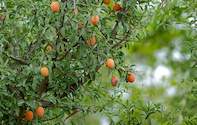This red-orange juicy fruit is called Ximenia caffra but is also known by its common names that include: sourplum, groot suurpruim, umThunduluka-obomvu, morokologa, iTsengeni, motshidi, pepo, mutanzwa and Amanumbilo.

The small tree with spiny tips also grows in America and was named after a Spanish monk Francisco Ximenez. The ‘caffra’ bit comes from the former name of an area in the Eastern Cape - Kaffraria. Inerestingly, Ximenia caffra can easily be confused with Ximenia americana.
The leaves of the X. americana are more blueish-green and the fruits are yellowish instead of red like the Ximenia caffra. The semi-parasitic tree can be found in the tropical eastern parts of Africa where it grows stronger when in contact with other root systems. It prefers sunny positions, is drought resistant and can withstand moderate frost.
The sourplum grows up to 50 cm per year and makes for a good hedge. The sour yet refreshing fruits are enjoyed by birds, animals (including giraffe and antelopes) as well as humans who use it to prepare jams and desserts.
The raw sourplum is best eaten slightly overripe, when it dries out slightly and tastes similar to a prune. Sourplum fruit is plum-shaped and varies in colour from yellow to dark red. It is harvested in the summer rainfall season from November to March.
Trees can yield 15-17kg of fruit per year. The fruit is often left in cold water to soak, then the pulp of the fruit is squeezed out, mixed with ground tubers and boiled to a porridge. The Zulu people squeeze the fruits into water - this juice is then boiled and mixed with maize meal to make a sour porridge. Sourplum fruit is high in vitamin C and potassium (K) and contains protein.
The fruit contains a single very tasty seed with a 65% oil content. The oil is used to in cosmetics to soften skin and for tanning leather. More than 60 human and animal ailments are treated with the sourplum plant including sexually transmitted infections and malaria.
Other medicinal uses of sourplum include soothing inflamed eyes and tonsillitis (decoction of the leaves), as a remedy for diarrhea (infusion of the root) and curing abdominal pain and bilharzia (infusion of root and leaves).
The powdered roots heal sores, TB (tuberculosis)-related diseases and when added to beer, act as an aphrodisiac, while the powdered leaves are reputed to cure infertility and break fevers. The sourplum is easily grown from a seed and should be planted in a 5:1 mix of river sand and compost.
Medical Disclaimer
Information is for educational and informational purposes only and may not be construed as medical advice. The information is not intended to replace medical advice or treatment offered by healthcare professionals.By Marinda Louw